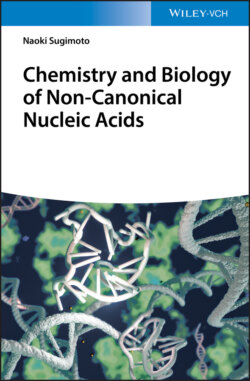Читать книгу Chemistry and Biology of Non-canonical Nucleic Acids - Naoki Sugimoto - Страница 13
1.3 Non-Watson–Crick Base Pair
ОглавлениеAlthough the discovery of Watson–Crick base pairs is famous, we need to make sure that Watson and Crick initially “proposed” their model. Moreover, Watson and Crick were not the first researchers who proposed the structure of nucleic acids. The physicist Linus Pauling, who earned the Nobel Prize two times in his career, first proposed the helix model of nucleic acids with his associate Robert Corey [4]. However, the structure was fault: it was a triple helix having negatively charged phosphates located at the core of the helix, which could not exist in nature. After the proposal of Watson–Crick base pairs, the race for determination of the helical structure of DNA had been started using purine and pyrimidine monomers. The first such study was reported in 1959, when Karst Hoogsteen – an associate of Robert Corey at Caltech – used single-crystal X-ray analysis to determine the structures of cocrystals containing 9-methyladenine and 1-methylthymine, where methyl groups were used to block hydrogen bonding to nitrogen atoms otherwise bonded to sugar carbons in DNA [5]. However, the structure was NOT Watson–Crick base pair, in which the adenine base was flipped upside down. The different base pair was later named Hoogsteen base pair (Figure 1.2 and see Chapter 2). After the discovery of Hoogsteen base pairs, many researchers looked for Watson–Crick base pairs. However, only Hoogsteen base pairs were identified. In 1973, Alexander Rich first discovered Watson–Crick base pairs in the cocrystal of the AU and GC dinucleoside phosphate complex [6]. And soon after, Richard E. Dickerson, who took over the Pauling's lab, first solved the single-crystal structure of a DNA dodecamer using heavy atom X-ray crystallography in 1980 [7]. It takes more than 20 years after the discovery of Watson–Crick base pairs. These results suggest that Watson–Crick base pairs tended to stably form under the constraint of the helical structure of nucleic acids, whereas Hoogsteen base pairs form in other structural conditions. Therefore, there are canonical structures composed by Watson–Crick base pairs in the duplex structures. On the other hand, non-canonical structures include non-Watson–Crick base pairs such as Hoogsteen base pairs.
Figure 1.2 Chemical structures of base pairs via Watson–Crick or Hoogsteen types.
Linus Pauling (left), Robert Corey (middle), and Karst Hoogsteen (right)Alexander Rich (left) and Richard E. Dickerson (right)
